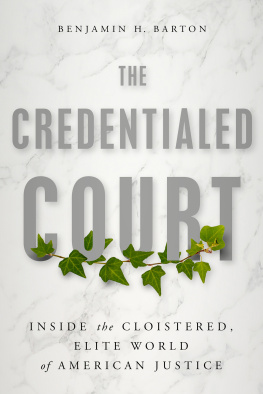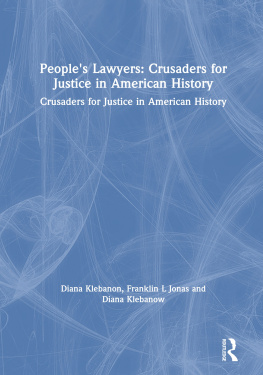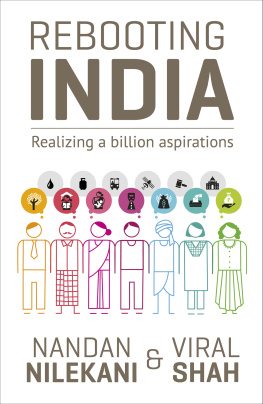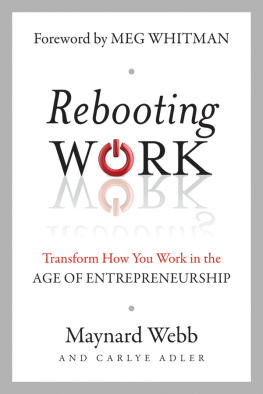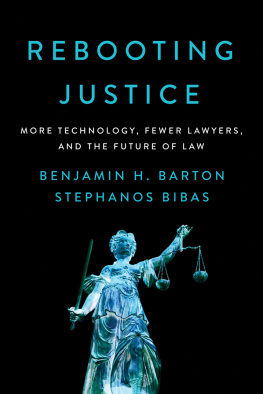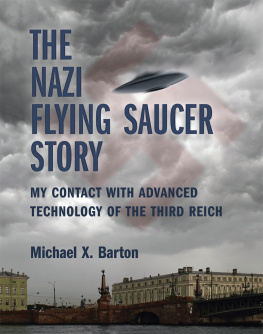Benjamin H. Barton - Rebooting Justice: More Technology, Fewer Lawyers, and the Future of Law
Here you can read online Benjamin H. Barton - Rebooting Justice: More Technology, Fewer Lawyers, and the Future of Law full text of the book (entire story) in english for free. Download pdf and epub, get meaning, cover and reviews about this ebook. year: 2017, publisher: Encounter Books, genre: Politics. Description of the work, (preface) as well as reviews are available. Best literature library LitArk.com created for fans of good reading and offers a wide selection of genres:
Romance novel
Science fiction
Adventure
Detective
Science
History
Home and family
Prose
Art
Politics
Computer
Non-fiction
Religion
Business
Children
Humor
Choose a favorite category and find really read worthwhile books. Enjoy immersion in the world of imagination, feel the emotions of the characters or learn something new for yourself, make an fascinating discovery.

- Book:Rebooting Justice: More Technology, Fewer Lawyers, and the Future of Law
- Author:
- Publisher:Encounter Books
- Genre:
- Year:2017
- Rating:3 / 5
- Favourites:Add to favourites
- Your mark:
- 60
- 1
- 2
- 3
- 4
- 5
Rebooting Justice: More Technology, Fewer Lawyers, and the Future of Law: summary, description and annotation
We offer to read an annotation, description, summary or preface (depends on what the author of the book "Rebooting Justice: More Technology, Fewer Lawyers, and the Future of Law" wrote himself). If you haven't found the necessary information about the book — write in the comments, we will try to find it.
Rebooting Justice: More Technology, Fewer Lawyers, and the Future of Law — read online for free the complete book (whole text) full work
Below is the text of the book, divided by pages. System saving the place of the last page read, allows you to conveniently read the book "Rebooting Justice: More Technology, Fewer Lawyers, and the Future of Law" online for free, without having to search again every time where you left off. Put a bookmark, and you can go to the page where you finished reading at any time.
Font size:
Interval:
Bookmark:
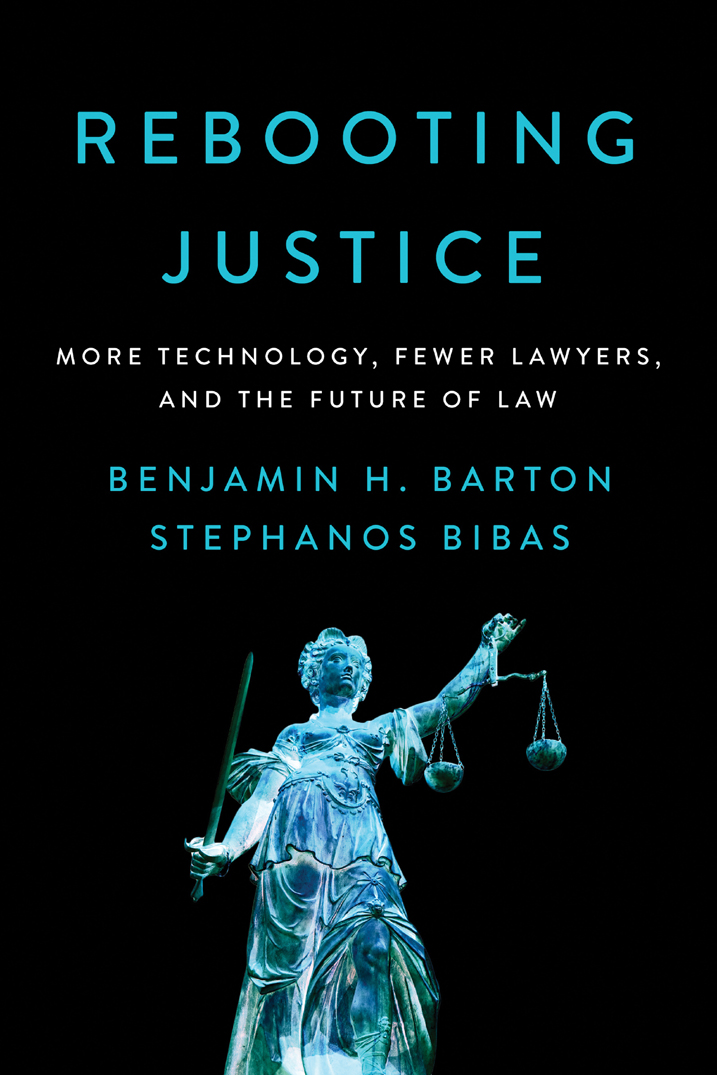



2017 by Benjamin H. Barton and Stephanos Bibas
All rights reserved. No part of this publication may be reproduced, stored in a retrieval system, or transmitted, in any form or by any means, electronic, mechanical, photocopying, recording, or otherwise, without the prior written permission of Encounter Books, 900 Broadway, Suite 601, New York, New York, 10003.
First American edition published in 2017 by Encounter Books, an activity of Encounter for Culture and Education, Inc., a nonprofit, tax exempt corporation.
Encounter Books website address: www.encounterbooks.com
FIRST AMERICAN EDITION
LIBRARY OF CONGRESS CATALOGING-IN-PUBLICATION DATA
Names: Barton, Benjamin H., 1969 author. | Bibas, Stephanos, author.
Title: Rebooting justice: more technology, fewer lawyers, and the future of law / by Benjamin H. Barton and Stephanos Bibas.
Description: New York: Encounter Books, 2017. | Includes bibliographical references and index.
Identifiers: LCCN 2016058767 (print) | LCCN 2016059671 (ebook) | ISBN 9781594039348 (Ebook)
Subjects: LCSH: Justice, Administration ofUnited States. | Law reformUnited States. | Legal servicesUnited States. | Technology and lawUnited States. | BISAC: LAW / Courts. | LAW / Criminal Law / General. | LAW / Civil Law. | LAW / Legal Services.
Classification: LCC KF384 .B374 2017 (print) | LCC KF384 (ebook) | DDC 347.73dc23
LC record available at https://lccn.loc.gov/2016058767
Table of Contents
Contents

F ans of the podcast Serial will recall the story of this high school murder: On January 13, 1999, Baltimore teenager Hae Min Lee disappeared after high school and was later found strangled and buried in a park. The next year, her ex-boyfriend Adnan Syed was convicted of her kidnapping and murder and sentenced to life imprisonment. There was no physical evidence linking Adnan to Haes murder, so at trial the State built its case on three main kinds of evidence: First, Adnans acquaintance Jay testified that Adnan had told him in advance that he was going to kill Hae and that, after the killing, Jay had helped Adnan to bury Haes body. Second, the State introduced cellphone call and location records that suggested that Adnan and Jay may have been together midafternoon on January 13 and that, the same evening, the cellphone was near the park where Hae was buried. Third, there was character evidence, some of which suggested that Adnan was angry about the breakup and was the kind of person who could have killed his ex-girlfriend. Also, Adnan offered no evidence to support an alibi or that he had tried to page Hae after she disappeared.
But, as Serial fans will also recall, the States case suffered from serious weaknesses. First, Jay had plenty of incentives to blame someone else to minimize his own punishment. Jay was a marijuana dealer who had had previous run-ins with the law. He repeatedly admitted, to police and to the jury, that he had lied about various facts to avoid blame or minimize punishment. By his own admission, he was involved in burying Haes body, which made him at least an accessory to murder and warranted suspicion that he was the killer. As Jay admitted, the police detectives threatened to charge him with Haes murder unless he implicated Adnan in the killing. Conversely, prosecutors offered him an extremely favorable plea bargain, under which he received only a suspended sentence and served no jail time. They also took the highly unusual step of getting him a specially selected private defense lawyer, perhaps to further his cooperation. And Jay kept changing details of his story, weakening its credibility.
Second, the cellphone call records conflicted with Jays own timeline. Jay admitted Adnan had lent him his car and cellphone for much of the day, so the presence of the phone near the grave site might implicate Jay rather than Adnan. And the details of the midafternoon call do not line up with the testimony of the woman who received that call: She vaguely remembers a call close to the evening, and testified that it happened while Adnan was at a job that he did not get until two weeks later. Third, the character evidence was conflicting, no one had accused Adnan of any remotely similar crimes before, and character evidence alone hardly suffices to prove a crime beyond a reasonable doubt. The same is true of Adnans lack of proof of an alibi or of trying to page Hae after her disappearance.
There was thus plenty of ammunition for a good defense attorney to use to create reasonable doubt. The lack of physical evidence often matters greatly to jurors used to CSI and similar crime shows. Jay was an admitted liar and drug dealer who had repeatedly changed his story to make it fit the police and prosecutions version of events. Character evidence is flimsy, and a good defense lawyer could easily have turned the cellphone records against the prosecution to highlight the implausibility of its timeline.
Adnans family and friends from his mosque banded together to hire Cristina Gutierrez, who, as a former public defender, had a reputation as a ferocious advocate. Unfortunately, Gutierrez performed terribly. She suffered from multiple sclerosis, and she repeatedly squeezed Adnans family for money without doing enough to prepare in return. Gutierrezs investigation was shoddy, and she failed to use alibi witness Asia McClain, who specifically remembered a long conversation with Adnan during the time when Adnan was supposedly strangling Hae. At trial, she was disorganized, had not mastered the facts, offered no expert witnesses or theory of the case, and was so aggressive that she made Jay seem reasonable.
Adnan may or may not have committed the murder, but we can have no confidence in his conviction because Gutierrez failed to put up a vigorous fight. Yet, to this day, he remains in prison. Today, a decade and a half later, the criminal justice system must wrestle again with whether to reopen Adnans conviction to make up for his shoddy defense.
Adnans case was not alone. About a dozen of Gutierrezs other clients said they had paid her, and sometimes she had come back to them asking for more, but she had not filed their pleadings in court. Gutierrez stopped communicating with her clients and has also been accused of seeking publicity and failing to pass along plea-bargain offers.
Gutierrezs dishonesty and uncommunicativeness were predictable and preventable. When she applied to become a lawyer, the Maryland bar authorities were warned that she had been convicted of shoplifting and apparently had lied about her surname to the police to hide that conviction. She had also omitted the conviction from her law school and job applications, yet Marylands highest court admitted her to the bar. As the dissenting judge put it, Given this young womans prior record, how can we know that her demonstrated qualities of dishonesty, untruthfulness, and lack of candor will not again rise to the surface? The bar authorities failed in their mission to ensure justice by ensuring high-caliber lawyering.
Adnans case is extreme, but not unusual. Appointed criminal defense lawyers are often wildly overburdened and so plead their clients guilty as quickly as they can. Right now, somewhere in America, an innocent criminal defendant faces very serious criminal charges with almost no hope of a vigorous defense.
Font size:
Interval:
Bookmark:
Similar books «Rebooting Justice: More Technology, Fewer Lawyers, and the Future of Law»
Look at similar books to Rebooting Justice: More Technology, Fewer Lawyers, and the Future of Law. We have selected literature similar in name and meaning in the hope of providing readers with more options to find new, interesting, not yet read works.
Discussion, reviews of the book Rebooting Justice: More Technology, Fewer Lawyers, and the Future of Law and just readers' own opinions. Leave your comments, write what you think about the work, its meaning or the main characters. Specify what exactly you liked and what you didn't like, and why you think so.

